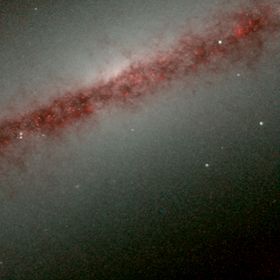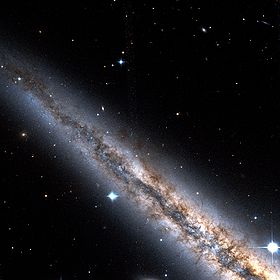- NGC 891
-
NGC 891 
Spiral Galaxy NGC 891Observation data (J2000 epoch) Constellation Andromeda Right ascension 02h 22m 33.4s[1] Declination +42° 20′ 57″[1] Redshift 528 ± 4 km/s[1] Distance 27.3 ± 1.8 Mly (8.4 ± 0.5 Mpc)[2] Type SA(s)b?[1] Apparent dimensions (V) 13′.5 × 2′.5[1] Apparent magnitude (V) 10.8[1] Other designations UGC 1831, PGC 9031,[1] Caldwell 23 See also: Galaxy, List of galaxies NGC 891 (also known as Caldwell 23) is an edge-on unbarred spiral galaxy about 30 million light-years away in the constellation Andromeda. It was discovered by William Herschel on October 6 1784. The galaxy is a member of the NGC 1023 group of galaxies in the Local Supercluster. It has an H II nucleus.[3]
The object is visible in small to moderate size telescopes as a faint elongated smear of light with a dust lane visible in larger apertures.
In 1999, the Hubble Space Telescope imaged NGC 891 in infrared.
In 2005, due to its attractiveness and scientific interest, NGC 891 was selected to be the first light image of the Large Binocular Telescope.[4]
Supernova SN 1986J was discovered on August 21, 1986 at apparent magnitude 14.[5]
Contents
Peculiarities
Although this galaxy looks as we think our own galaxy would look like when viewed edge-on, recent high-resolution images of its dusty disk show unusual filamentary. These patterns are extending into the halo of the galaxy, away from its galactic disk. Scientists presume that supernova explosions caused this interstellar dust to be thrown out of the galactic disk toward the halo.[6]
It may also be possible that the light pressure from surrounding stars causes this phenomenon.[7]
Investigations done by Gilbert A. Esquerdo and John C. Barentine in infrared give rise to suspects that it has the Hubble type SBb with a bar. This bar, if it exists, cannot be seen in the visible image, as it is edge-on from our perspective. The bar hypothesis is also supported by the fact that billions of stars orbiting the center appear to be moving too fast.[8] The galaxy is a member of a small group of galaxies, sometimes called the NGC 1023 group. Other galaxies in this group are the NGCs 925, 949, 959, 1003, 1023, and 1058, and the UGCs 1807, 1865 (DDO 19), 2014 (DDO 22), 2023 (DDO 25), 2034 (DDO 24), and 2259.[9] The outskirts with low surface brightness are populated by multiple, coherent, and vast substructures, like giant streams that loop around the parent galaxy up to distances of approximately 50 kpc. The bulge and the disk are surrounded by a flat and thick cocoon-like stellar structure. These have vertical and radial distances of up to 15 kpc and 40 kpc, respectively.[10]
In popular culture
The soundtrack of the 1974 film Dark Star by John Carpenter features an instrumental piece called When Twilight Falls On NGC 891.[11]
The first solo album by Edgar Froese, Aqua, contained a track called "NGC 891".
See also
- Cigar Galaxy
References
- ^ a b c d e f g "NASA/IPAC Extragalactic Database". Results for NGC 891. http://nedwww.ipac.caltech.edu/cgi-bin/nph-objsearch?objname=NGC+891&img_stamp=yes&extend=no. Retrieved 2006-11-18.
- ^ J. L. Tonry, A. Dressler, J. P. Blakeslee, E. A. Ajhar, A. B. Fletcher, G. A. Luppino, M. R. Metzger, C. B. Moore (2001). "The SBF Survey of Galaxy Distances. IV. SBF Magnitudes, Colors, and Distances". Astrophysical Journal 546 (2): 681–693. arXiv:astro-ph/0011223. Bibcode 2001ApJ...546..681T. doi:10.1086/318301.
- ^ Ho, Luis C.; Filippenko, Alexei V.; Sargent, Wallace L. W. (October 1997). "A Search for "Dwarf" Seyfert Nuclei. III. Spectroscopic Parameters and Properties of the Host Galaxies". Astrophysical Journal Supplement 112 (2): 315–390. arXiv:astro-ph/9704107. Bibcode 1997ApJS..112..315H. doi:10.1086/313041.
- ^ "LBT - First Light, Description". Large Binocular Telescope Corporation. 2008. Archived from the original on 2010-11-06. http://www.webcitation.org/5u2P9Ltpx.
- ^ "List of Supernovae". Harvard-Smithsonian Center for Astrophysics (IAU). http://cbat.eps.harvard.edu/lists/Supernovae.html#1986J. Retrieved 2010-05-19.
- ^ "Interstellar Dust Bunnies of NGC 891". Astronomy Picture of the Day. 2002. http://apod.nasa.gov/apod/ap020703.html. Retrieved 2011-01-29.
- ^ "NGC 891 in Andromeda". Wilhelm-Förster Observatory, Berlin. 2001. http://www.planetarium-berlin.de/PotW/01_41/PotW.html. Retrieved 2011-01-29.
- ^ "Edge-On Spiral Galaxy NGC 891". APOD. 1997. http://apod.nasa.gov/apod/ap970228.html. Retrieved 2011-01-29.
- ^ "NGC 891". SEDS. 2009. http://seds.org/messier/xtra/ngc/n0891.html. Retrieved 2011-01-29.
- ^ Mouhcine; Ibata; Rejkuba (2010). "A panoramic view of the Milky Way analogue NGC 891". arXiv:1002.0461 [astro-ph.GA].
- ^ The Cinema of John Carpenter. Wallflower Press. 2004. p. 53. http://books.google.com/books?id=luhZyiXodCUC&pg=PA53&lpg=PA53&dq=%22twilight+falls+on+NGC+891%22#v=onepage&q=%22twilight%20falls%20on%20NGC%20891%22&f=false. Retrieved 2011-06-08.
External links
- NGC 891 on WikiSky: DSS2, SDSS, GALEX, IRAS, Hydrogen α, X-Ray, Astrophoto, Sky Map, Articles and images
- APOD: Interstellar Dust-Bunnies of NGC 891 (9/9/1999)
- SEDS: Information on NGC 891
- NGC 891 on Astrophotography by Wolfgang Kloehr
Coordinates:
 02h 22m 33.4s, +42° 20′ 57″
02h 22m 33.4s, +42° 20′ 57″Astronomical catalogs NGC: NGC 889 - NGC 890 - NGC 891 - NGC 892 - NGC 893 PGC: PGC 9029 - PGC 9030 - PGC 9031 - PGC 9032 - PGC 9033 UGC: UGC 1829 - UGC 1830 - UGC 1831 - UGC 1832 - UGC 1833 Caldwell: C21 - C22 - C23 - C24 - C25 The Caldwell catalogue List C1 · C2 · C3 · C4 · C5 · C6 · C7 · C8 · C9 · C10 · C11 · C12 · C13 · C14 · C15 · C16 · C17 · C18 · C19 · C20 · C21 · C22 · C23 · C24 · C25 · C26 · C27 · C28 · C29 · C30 · C31 · C32 · C33 · C34 · C35 · C36 · C37 · C38 · C39 · C40 · C41 · C42 · C43 · C44 · C45 · C46 · C47 · C48 · C49 · C50 · C51 · C52 · C53 · C54 · C55 · C56 · C57 · C58 · C59 · C60 · C61 · C62 · C63 · C64 · C65 · C66 · C67 · C68 · C69 · C70 · C71 · C72 · C73 · C74 · C75 · C76 · C77 · C78 · C79 · C80 · C81 · C82 · C83 · C84 · C85 · C86 · C87 · C88 · C89 · C90 · C91 · C92 · C93 · C94 · C95 · C96 · C97 · C98 · C99 · C100 · C101 · C102 · C103 · C104 · C105 · C106 · C107 · C108 · C109See also Categories:- Spiral galaxies
- Unbarred spiral galaxies
- Andromeda constellation
- NGC objects
- UGC objects
- PGC objects
- Caldwell objects
Wikimedia Foundation. 2010.


